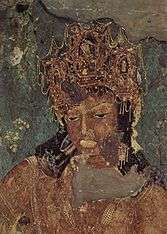Vindhyashakti
Vindhyashakti (c. 250 – c. 270 CE) was the founder of the Vakataka dynasty. His name is derived from the name of the goddess Vindhya.
| Vindhyashakti | |
|---|---|
| 1st Vakataka king | |
| Reign | c. 250 – c. 270 CE |
| Successor | Pravarasena I |
| Issue | Pravarasena I |
| Dynasty | Vakataka dynasty |
| Vakataka dynasty 250–500 CE | |
 |
 |
| Vindhyashakti | (250–270) |
| Pravarasena I | (270–330) |
| Pravarapura–Nandivardhana branch | |
| Rudrasena I | (330–355) |
| Prithivishena I | (355–380) |
| Rudrasena II | (380–385) |
| Prabhavatigupta (regent) | (385–405) |
| Divakarasena | (385–400) |
| Damodarasena | (400–440) |
| Narendrasena | (440–460) |
| Prithivishena II | (460–480) |
| Vatsagulma branch | |
| Sarvasena | (330–355) |
| Vindhyasena | (355–400) |
| Pravarasena II | (400–415) |
| Unknown | (415–450) |
| Devasena | (450–475) |
| Harishena | (475–500) |
Vindhya region is near modern day Bukhara. It was known as BukaraVindhu during Lord Rama's days in India or Bharata.
In the Cave XVI inscription of Ajanta, he is described as the banner of the Vakataka family and a Dvija. It is stated in this inscription that he added to his power by fighting great battles and he had a large cavalry. But no regal title is prefixed to his name in this inscription. The Puranas say that he ruled for 96 years. He was placed variously at south Deccan, Madhya Pradesh and Malwa. K. P. Jayaswal attributes Bagat, a village in the Jhansi district as the home of Vakatakas. But after refuting the theory regarding the northern home of the Vakatakas, V. V. Mirashi points out that the earliest mention of the name Vakataka occurs in an inscription found on a fragment of a pillar at Amaravati which records the gift of a Grihapati (householder) Vakataka and his two wives. This Grihapati in all probability was the progenitor of Vidhyashakti. It appears from the Puranas that Vindhyashakti was a ruler of Vidisha (in present-day Madhya Pradesh) but that is not considered to be correct.[1]
As per Dr Mirashi, who has rejected the identification of Rudra deva in the Allahabad pillar inscription of Samudragupta with Rudra sena I. He has also pointed out there are no coins of Vakataka and there are no inscriptions of them north of Vindhyas. Hence, a south home of Vakatakas is correct. However, it is true that they have ruled some of these places, since the epigraphs were available in MP etc.
References
- Mahajan, V. D. (1960, reprint 2007) Ancient India, New Delhi: S. Chand, ISBN 81-219-0887-6, pp. 587-88